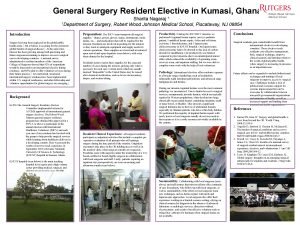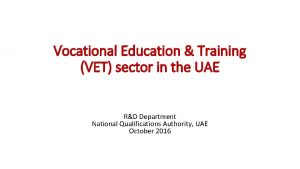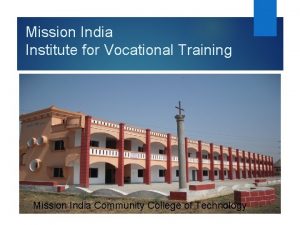Transforming Vocational Training in India Mr K Nagaraj




- Slides: 4

Transforming Vocational Training in India Mr. K. Nagaraj Naidu Director (Investments & Technology Promotion) Ministry of External Affairs


Transforming Vocational Education & Training (VET) System • Learning must be hands-on, contextualized, and applied. • Introduce a “dual-track” system where students get to go to a vocational school for general education and a company where the practical training takes place. • Curriculum to be responsive to industry demands: Curriculum to be designed by State together with industry organizations, and enterprises to make sure the content is relevant and future-oriented content. q Gurdaspur (Punjab) has 800 foundry forge units but the town’s ITI has no course that might cater to the unit’s needs for skilled manpower. • Provide standards and qualifications widely recognized in the labor market and continually adjusted to the leading edge of industries, including the increasingly global nature of occupations. • Branding: Address the low public perception of VET by creating a brand that makes vocational education an attractive opportunity to young people who have options. • Flexibility: Provide opportunities for students to move from vocational track to academic, university track and vice-versa. • Provide incentives adequate to attract qualified students to each level of the skills training system. q stipend for rural students for boarding and lodging, q making tuition fee free of cost • Create incentives for company/enterprise participation in vocational training. q Allotment of land at subsidized prices. q Preferential treatment/Credits in award of projects. q Tax breaks

Other Suggestions • Training to be related to the demands of the economy, in • Cutting down the pace of migration to urban centers terms of occupations and levels of qualifications needed to from rural areas: operate the economy. q AADHAR card to provide benefits for rural dwellers: q In the city of Chongqing (China) the shares of primary, v Fee concessions to attend vocational training. secondary and tertiary sectors are 8, 55 and 37 per cent v Benefits for female enrollment in vocational respectively. Accordingly, the focus of curriculum in training – fee waiver, grant to buy bicycle etc. Vocational centers in this city for the respective sectors q Enterprises that set up rural operations to be given is 7, 52 and 41 per cent respectively. benefits. q Chongqing today is the laptop manufacturing hub of the world. • Sister-State Program: States that have done exceedingly well in promoting industry must adopt States that have • Instructors to have industry experience and whose yet to exploit their economic potential. knowledge of the industry is fully current with state-of-theq For example: Maharashtra could adopt Sikkim and art practice. encourage some of its industries to establish bases in that State. Enterprises that do so are given • Provide incentives and training to attract the necessary concessions by Sikkim and tax breaks and other number and quality of instructors for each occupational benefits by Maharashtra state for the company’s group and qualification level. local operations. • Tap Young: Starting a vocational stream in every secondary school in India







